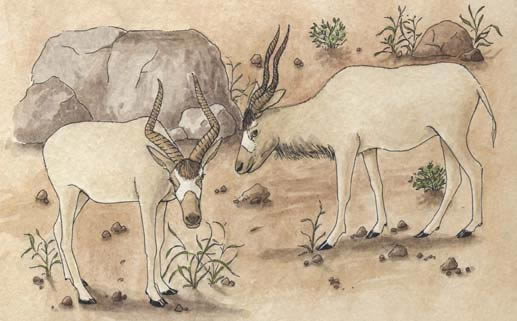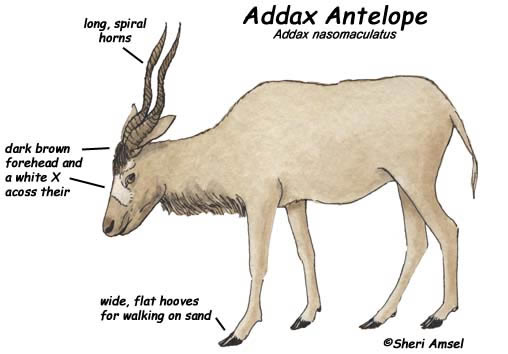

They are found in Northern Africa. They are very endangered.
They live in desert steppes (stony desert areas).
They are 5.5 feet long (170 cm) and weigh up to 275 pounds (125 kg). They have long, spiral horns (both males and females). They are buffy-colored with a dark brown forehead and a white X across their face. They have wide, flat hooves for walking on sand.
They sit in the shade, digging a hollow in the sand to lie in, behind a large rock that protects them from the wind. They are active at night when it is cooler (nocturnal).
They eat grasses, plants and leaves. They don’t need to drink water to survive, as they get enough moisture in the things they eat.
They were historically hunted by lions, hyena and leopard, but few survive where the addax now live.
Females are pregnant for about 9 months (gestation) and have 1 young.
They can live up to about 20 years. They are listed as critically endangered.
Kingdom: Animalia
Phylum: Chordata
Subphylum: Vertebrata
Class: Mammalia
Order: Artiodactyla
Family: Bovidae
Subfamily: Hippotraginae
Genus: Addax
Species: Addax nasomaculatus
When you research information you must cite the reference. Citing for websites is different from citing from books, magazines and periodicals. The style of citing shown here is from the MLA Style Citations (Modern Language Association).
When citing a WEBSITE the general format is as follows.
Author Last Name, First Name(s). "Title: Subtitle of Part of Web Page, if appropriate." Title: Subtitle: Section of Page if appropriate. Sponsoring/Publishing Agency, If Given. Additional significant descriptive information. Date of Electronic Publication or other Date, such as Last Updated. Day Month Year of access < URL >.
Amsel, Sheri. "Antelope (Addax)" Exploring Nature Educational Resource ©2005-2024. December 13, 2024
< http://www.exploringnature.org/db/view/Antelope-Addax >

